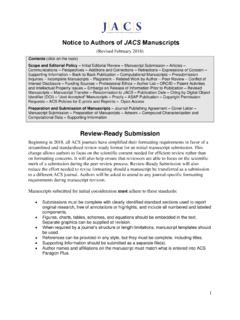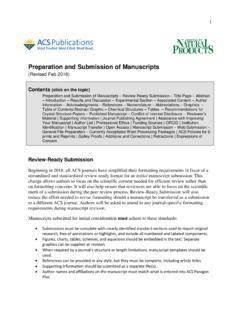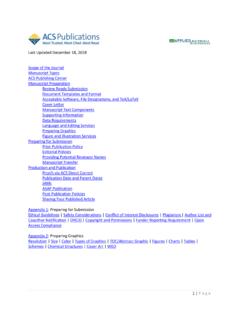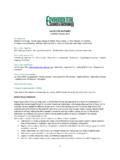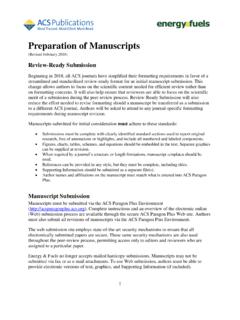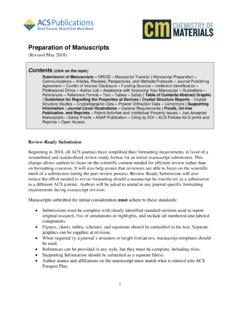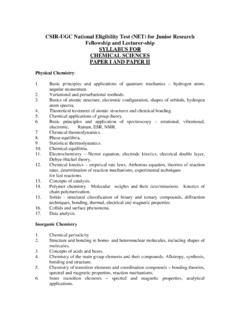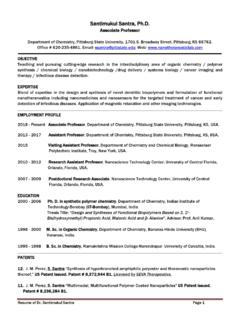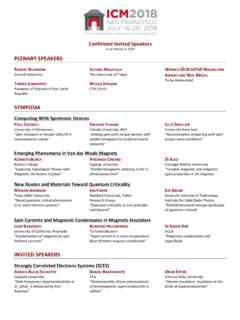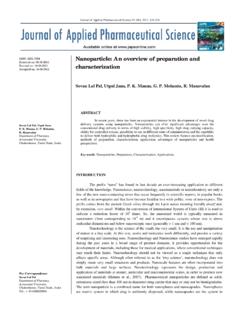Transcription of Information for Authors - ACS Publications Home …
1 1 Information for Authors February 2018 Contents (click on the topic) Scope | Types of Content | Articles Reviews Perspectives Conversations Nano Focus Letters to the Editor Additions and Corrections Retractions Editorial Policy | Submissions Manuscript Transfer Service Manuscript Assistance The Peer-Review Process Just Accepted Manuscripts Professional Ethics Publication Date and Patent Dates Proofs Online Publication ( Articles ASAP ) Embargo on Release of Information Prior to Publication Additions and Corrections ACS Policies for E-prints and Reprints Manuscript Submission | ORCID Cover Letter Related Work by Author Journal Publishing Agreement Assistance with English Language Editing Conflict-of-Interest Disclosure Funding Sources Author List Material and Data Availability Security Concerns Received Date Manuscript Preparation | Acceptable File Formats Preparing and Submitting Manuscripts Using TeX/LaTeX ACS Math Style Writing Style and Language Usage Nomenclature Organization of Paper Characterization and Database Deposition Supporting Information Web-Enhanced Objects Graphics Quality and Format Review-Ready Submission Beginning in 2018, all ACS journals have simplified their formatting requirements in favor of a streamlined and standardized review-ready format for an initial manuscript submission.
2 This change allows Authors to focus on the scientific content needed for efficient review rather than on formatting concerns. It will also help ensure that reviewers are able to focus on the scientific merit of a submission during the peer review process. Review-Ready Submission will also reduce the effort needed to revise formatting should a manuscript be transferred as a submission to a different ACS journal. Authors will be asked to attend to any journal-specific formatting requirements during manuscript revision. Manuscripts submitted for initial consideration must adhere to these standards: Submissions must be complete with clearly identified standard sections used to report original research, free of annotations or highlights, and include all numbered and labeled components. Figures, charts, tables, schemes, and equations should be embedded in the text. Separate graphics can be supplied at revision. When required by a journal s structure or length limitations, manuscript templates should be used.
3 References can be provided in any style, but they must be complete, including titles. Supporting Information should be submitted as a separate file(s). Author names and affiliations on the manuscript must match what is entered into ACS Paragon Plus. 2 SCOPE ACS Nano is an international forum for the rapid publication of peer-reviewed research that embraces the interfaces between chemistry, physics, materials science, biology, and engineering. The mission of the journal is to facilitate communication among scientists from these fields that will translate into new research opportunities and discoveries. ACS Nano includes definitive and comprehensive articles on the following topics: Synthesis, assembly, characterization, dynamics, measurement, theory, and simulation of nanostructures nanomaterials and nanoassemblies nanodevices self-assembled structures Nanobiotechnology, nanomedicine, and nanobiophysics Single-molecule methods and measurements Toxicity of nanomaterials Nanofabrication and novel lithographic methods Methods and tools for nanoscience and nanotechnology Self-assembly and directed assembly It is understood that submitted work is based upon original results and has not been published previously.
4 In addition, invited perspectives, commentaries, and reviews written by leading researchers in the field and conversations with founders, thought leaders, and public officials provide distinctive views about the future of nanoscience and nanotechnology. TYPES OF CONTENT Articles Concise, yet comprehensive reports of original research presenting an advance of immediate, broad, and lasting impact. Articles are not intended to be follow-up papers, unless they contain new and extensive Information that will advance the understanding of the field. Articles contain an abstract of ~250 words, providing a succinct, informative summation of the most important results and conclusions; no references may be cited in the abstract, and abbreviations and acronyms should not be introduced unless essential. An unheaded introduction of 1000 words should expand on the background of the work, with relevant references but not a complete survey of the literature. The introduction should be followed by Results and Discussion; a detailed Methods section should be presented at the end of the text.
5 Typically, Articles include several graphics (color images are encouraged) and 30 or more references. Supporting Information and Web-Enhanced Objects may be included. Articles include 5 7 lowercase keywords and a graphical Table of Contents entry. Articles should not contain claims of novelty, as all manuscripts submitted to ACS Nano are expected to contain novel components. 3 Reviews Topical, forward looking, and of general interest to the readership. Length is flexible (6 20 or more pages). A good review critically evaluates existing work of multiple groups in a field or across disciplines, provides a logical organization, and makes the material more easily available to those not expert in the area through clear text and figures. Reviews should lay out the challenges and opportunities that lie ahead. Reviews should contain an abstract and appropriate references. The use of graphics to illustrate key concepts is strongly encouraged. Reviews include a graphical Table of Contents entry.
6 Reviews also include ~8 10 keywords and a vocabulary section in which 5 7 terms extracted from the text are defined in one or two sentences. Reviews are generally submitted by invitation only. Review suggestions may be directed to the Editor. Reviews should not contain claims of novelty, as all manuscripts submitted to ACS Nano are expected to contain novel components. Perspectives Brief reports (3 5 journal pages) summarizing a research or finding of particular interest to nanoscientists and nanotechnologists. Perspectives can also elaborate on important unanswered questions and approaches being taken to address them. These reports are not intended to be comprehensive looks at the field, but rather to place a particular research finding into broader context. Perspectives must contain a brief abstract of ~120 words and ~20 references. Perspectives include a graphical Table of Contents entry. These papers are written exclusively at the invitation of the Editor. Perspectives should not contain claims of novelty, as all manuscripts submitted to ACS Nano are expected to contain novel components.
7 Conversations Profiles of people who help advance nanoscience and nanotechnology. These pieces are written by ACS Nano Editors. If you know a person who you think should be profiled, please contact the Editor. Nano Focus These pieces may focus on meetings, policy, or education. Nano Focus articles alert the readership to interesting developments that may impact the field. Nano Focus pieces must contain a brief abstract of ~120 words and a graphical Table of Contents entry. Nano Focus pieces are written by invitation only. If you have a topic that you think should be covered, please contact the Editor. Letters to the Editor ACS Nano will consider Letters to the Editor. Letters to the Editor should be brief and may be edited for conciseness and clarity. Note that Letters to the Editor that comment on research findings previously published in ACS Nano will be forwarded to the original author, who may rebut the Letter to the Editor. If the original Authors respond to the Letter to the Editor, both pieces are often scheduled to be published simultaneously.
8 ACS Nano will not accept Letters to the Editor that comment on research published elsewhere. Additions and Corrections Additions and Corrections may be used to address important issues or correct errors and omissions of consequence that arise after publication of an article. Additions and Corrections 4 may be requested by the author(s) or initiated by the Editor after discussions with the corresponding author. Readers who detect errors of consequence in the work of others should contact the corresponding author of that work. All Additions and Corrections are subject to approval by the Editor, and minor corrections and additions will not be published. Additions and Corrections from Authors should be submitted via the ACS Paragon Plus Environment by the corresponding author for publication in the Addition/Correction section of the Journal. The corresponding author should obtain approval from all of the article co- Authors prior to submitting an Addition and Correction or provide evidence that such approval has been solicited.
9 The Addition and Correction should include the original article title and author list, citation including DOI, and details of the correction. For proper formatting, see examples in a current issue of the Journal. Retractions Articles may be retracted for scientific or ethical reasons. Articles that contain seriously flawed or erroneous data such that their findings and conclusions cannot be relied upon may be retracted in order to correct the scientific record. Retractions may be requested by the article author(s) or by the journal Editor(s) but are ultimately published at the discretion of the Editor. When an article is retracted, a notice of Retraction will be published containing Information about the original article title, author list, and the reason for the Retraction. Retracted articles will be accompanied by the related Retraction notice and will be marked as Retracted . The originally published article will remain on the Web except in extraordinary circumstances ( , where deemed legally necessary, or if the availability of the published content poses public health risks).
10 The American Chemical Society follows guidance from the Committee on Publication Ethics (COPE) when considering retractions; for more Information , see Expressions of Concern The American Chemical Society (ACS) follows guidance from the Committee on Publication Ethics (COPE) when considering expressions of concern; for more Information see: In accordance with COPE guidelines, expressions of concern may be issued if: there is inconclusive evidence of research or publication misconduct by the Authors ; there is evidence that the findings are unreliable but the Authors institution will not investigate the case; an investigation into alleged misconduct related to the publication either has not been, or would not be, fair and impartial or conclusive; an investigation is underway but a judgment will not be available for a considerable time. Expressions of concern are published at the discretion of the Editor-in-Chief. Upon completion of any related investigation, and when a final determination is made about the outcome of the article, the expression of concern may be replaced with a retraction notice or correction.
